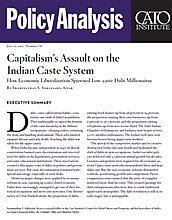When India became independent in 1947, its liberal constitution banned caste discrimination and reserved seats for dalits in the legislatures, government services, and some educational institutions. These reservations created a thin upper crust of dalits in politics and government services. But caste discrimination remained wide spread and savage, especially in rural India.
However, major changes were sparked by economic reforms in 1991, opening up a once-closed economy. Dalits have increasingly managed to get out of their historical occupations and move into new ones. One district survey in Uttar Pradesh shows the proportion of dalits owning brick houses up from 38 percent to 94 percent, the proportion running their own businesses up from 6 percent to 36.7 percent, and the proportion owning cell phones up from zero to one-third. The Dalit Indian Chamber of Commerce and Industry now boasts of over 3,000 member-millionaires. The former serfs have now become bosses hiring upper-caste workers.
The arrival of the competitive market and its creative destruction broke old caste bonds and facilitated the shift of dalits to new occupations. India’s socialist policies achieved only 3.5 percent annual growth for decades. Licences and permits were required for all economic activity. Upper-caste networks monopolized these and kept dalits out. But the 1991 economic reforms dismantled controls, accelerating growth and competition. Fierce competition soon ensured that the price of a supplier mattered more than his caste. This created openings for dalit entrepreneurs, who were able to crack traditional upper-caste monopolies. The dalit revolution is still in its early stages, but is unstoppable.

